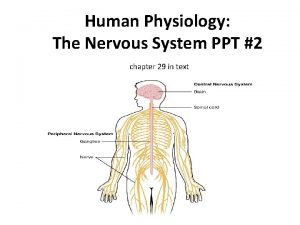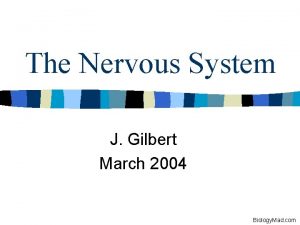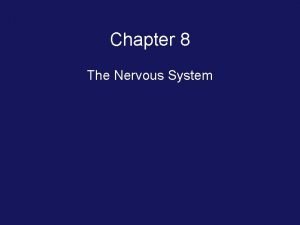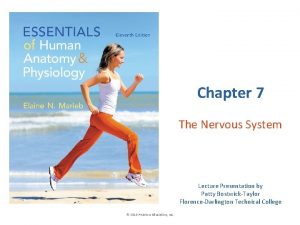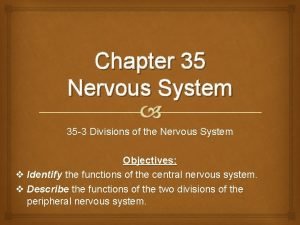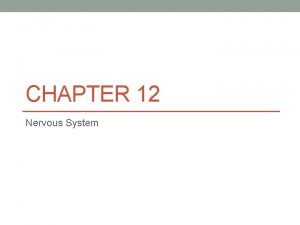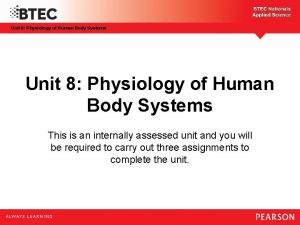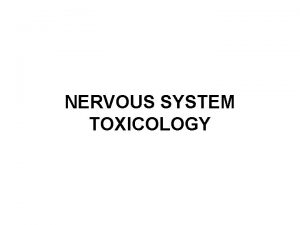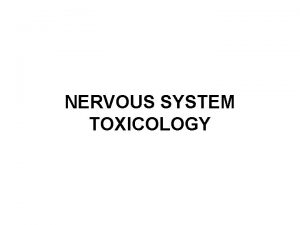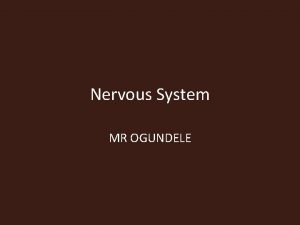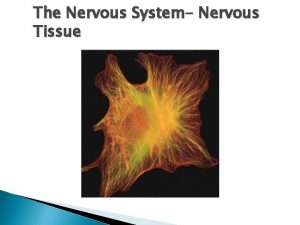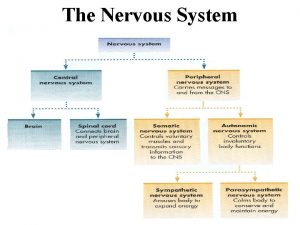Human Physiology The Nervous System PPT 2 chapter
























- Slides: 24

Human Physiology: The Nervous System PPT #2 chapter 29 in text

Objectives and Questions: • 1. I can describe the functions of the nervous system • 2. I can describe the parts of a neuron cell and identify how they transmit electrochemical impulses. • 3. I can compare and contrast the central and peripheral nervous systems • 4. I can identify and explain different areas of the brain and their functions. • 5. I can explain how the nervous system passes information between the external environment and the many parts of the body.

The Nervous system is: • A physically connected network of cells, tissues and organs that allow us to communicate with and react to the environment and perform life activities.

Cool Nervous System Facts: • As a fetus in the womb, neurons develop at the rate of 250, 000 per minute. • We have about 100 billion nerve cells in our brain by adulthood (over 600 miles worth) – yet we typically use around 4% at any given time • Neurons are our largest cells • Messages transmit at speeds up of to 180 MPH

FOUR PRIMARY FUNCTIONS OF NERVOUS SYSTEM 1. Sensing the world l 2. 3. 4. Vision, Hearing, Smell, Taste, Touch Transmitting information Processing information Producing a response

The functional unit of the nervous system is the nerve cell, the NEURON l They send electrochemical messages around the body l Glial cells provide support and protection for neurons l

Parts of a neuron Nerve Cell

Parts of nerve cell Dendrites : recieve chemical signals from neighboring cells. l Cell Body: contains the nucleus & organelles l Axon: long extension that carries electrical messages away from the body to the terminal axons l Terminal Axons: passes the signal to the next cell. l Myelin sheath: Protective covering for axon l

Types of Neurons l 3 main types of neurons: l. Sensory neuron = detect stimuli l. Interneurons = relay sensory signals to brain then return message back to motor neurons. l. Motor neuron = pass message from brain to rest of body for muscle response l. This coordinated pathway is known as the REFLEX ARC


Reflex Arc “ what happens when you step on a nail”? l l Reflexes are automatic The Stimulus (nail ) is received by the sensory neurons in the foot This info travels to the spine, where the interneuron is triggered The interneuron transmits signal to brain (through the spinal cord)and carries message back and stimulates the motor neuron, to move the foot

A progressive wave of electric and chemical activity along a nerve fiber that stimulates or inhibits the action of a muscle, gland, or other nerve cell *This is how the information moves from sensory neurons to interneuron to motor neurons


2 MAIN DIVISIONS: Central Nervous System (CNS) Receives, interprets and sends signals to PNS Has 2 main parts: Brain – main control center Spinal Cord – connects and relays nerve impulses to the brain

PERIPHERAL NERVOUS SYSTEM (PNS) Connects CNS to all organ systems Made up of: � Sensory Neurons: detect stimuli � Motor Neurons: carry signal to stimulate response 2 major subsystems: � Somatic – voluntary movement (balance, movement) � Autonomic – involuntary movement (digestion, fight or flight)

Parts of the Nervous System l Central Nervous System Peripheral l Autonomic l Sympathetic l Brain l Cerebrum l Cerebellum l Brain Stem and Pons l Lobes (4) l Spinal l Cord l “information superhighway” l Fight or Flight l Parasympathetic l Relaxation l Somatic l Sensory and Motor Nerves l Reflex Arc




• Smaller part of the brain , towards the back FUNCTIONS: • Coordinates all movement • Helps maintain posture, muscle control, and balance

Large front part of the brain FUNCTIONS: l l Voluntary activity l Memory l Language l Receives l Controls and responds to sensory signals motor functions

Top layer of the brain Stores: experiences and/or learning Frontalbehavior & emotion Parietal. Sensory info concerning touch Occipital- vision Temporal- memory & emotion, speech and hearing

BRAIN STEM l swallowing, coughing, sneezing, and vomiting PONS l Breathing l Heart rate l Internal Organs Includes the Medulla Oblongata • Damage in this area will usually kill you. l Medulla

“controls: emotions and memories” Damage to these areas can lead to amnesia or emotional disturbances
 The nervous system
The nervous system Neuronal pools
Neuronal pools Nervous
Nervous Neuronal pools are collections of
Neuronal pools are collections of The human nervous system biology mad
The human nervous system biology mad Ppt
Ppt Chapter 1 introduction to human anatomy and physiology
Chapter 1 introduction to human anatomy and physiology Distal and proximal
Distal and proximal Chapter 2 human reproductive anatomy and physiology
Chapter 2 human reproductive anatomy and physiology Nervous system and digestive system
Nervous system and digestive system Endocrine system vs nervous system
Endocrine system vs nervous system General mechanism of hormone action
General mechanism of hormone action Adh function
Adh function Appendicular skeleton pectoral girdle
Appendicular skeleton pectoral girdle Chapter 7 the nervous system
Chapter 7 the nervous system Chapter 15 nervous system diseases and disorders
Chapter 15 nervous system diseases and disorders Chapter 8 the nervous system
Chapter 8 the nervous system Chapter 7 the nervous system figure 7-2
Chapter 7 the nervous system figure 7-2 Chapter 35 nervous system
Chapter 35 nervous system Chapter 14 lesson 3 the nervous system
Chapter 14 lesson 3 the nervous system Chapter 12 nervous system
Chapter 12 nervous system 3 layers of muscle
3 layers of muscle Unit 8 physiology of human body systems assignment 1
Unit 8 physiology of human body systems assignment 1 Animal physiology exam 1
Animal physiology exam 1 Holes essential of human anatomy and physiology
Holes essential of human anatomy and physiology
